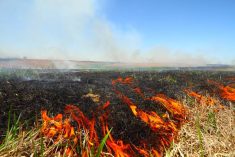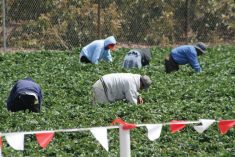Spring is a time of hope and Randy Schmitz’s hope is that Alberta farmers will slow down a little as they begin a new growing season.
Rollovers, run-overs, and being pinned or struck by a machine component are the leading causes of agriculture-related injuries and fatalities, said Schmitz, chairman of the Alberta Vehicle Extrication Association.
“We see the biggest increase from May to September, because it’s seeding and harvest,” he said, adding the risk is particularly high at harvest.
“They’re under such pressure to get the crops off, and so they work from dawn until dusk, and with that comes a lot of risk. People are more willing to take risks to speed up the production to get their crops off.”
Read Also

Farming Smarter receives financial boost from Alberta government for potato research
Farming Smarter near Lethbridge got a boost to its research equipment, thanks to the Alberta government’s increase in funding for research associations.
Farmers generally understand the dangers on the farm, but may not take them as seriously as they should, he said.
“It’s partially education, but for the most part, people are playing the odds,” he said.
A classic mistake is removing safety protection from a machine, said Schmitz.
“With auger entrapments, it’s usually because the guards have been removed,” he said. “They see them as a hindrance, so they remove them, and then they don’t get put back on.
“A lot of manufacturers are doing a good job of making it more difficult to remove the guards. So they’re doing their part to make it safe, but sadly some farmers still try to do their best to override that.
“It’s getting better, but there’s still an old-school mentality on operating the farm.”
Farmers also have some misconceptions about how quickly they can respond in an emergency situation, he added.
“People think that if they don’t wear their seatbelt, they have a chance to jump out of the way,” said Schmitz. “But often what happens is they can’t do it quickly and they get trapped underneath. In a second, it’s done — and they don’t have a fighting chance a lot of times. So seatbelts need to be used in tractors.”
Grain bin entrapments can happen just as quickly.
“Fatalities are super high there because usually you don’t have any time to react and respond,” he said. “On average, somebody can become engulfed in about eight seconds. It’s literally under 10 seconds before someone is completely engulfed. The survivability with engulfments is really, really low.”
So producers need to “get away from that old-school mentality” around farm equipment safety if they hope to prevent some of these on-farm accidents, he said.
Read and follow your operator’s manual, conduct safety meetings with your family and workers, and create an emergency procedure that outlines what to do in the event something goes wrong.
“Prevention is probably the biggest key when it comes to these things,” said Schmitz. “It’s probably going to take a little longer to get your crop off, but it’s sure a hell of a lot better than having to bury one of your kids or your workers.”
The Alberta Vehicle Extrication Association will be hosting farm machinery rescue training this summer (assuming social distancing regulations are no longer in effect). And while it’s designed for first responders, farmers themselves can benefit from learning how to prevent an entrapment — and what to do if an entrapment occurs.
“If your neighbour is in trouble, you might be one of the first people they call for help.”
For more information, visit albertavx.com.















